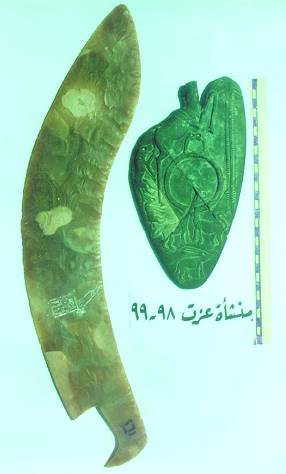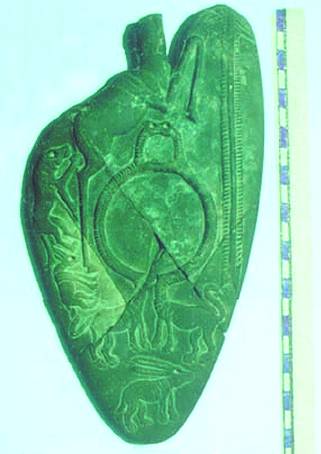Tombs in an Old Kingdom Necropolis
Work still going on to reveals more objects discovered in Monshaet Ezzat.
Reported by Naglaa Habib El Zahlawi
El Dakahlia governorate located in the
central Delta includes many important archaeological sites as the area used to be the
sixteenth and the seventeenth Nome of Lower Egypt during the pharaonic era. The sites that
revealed important remains are mainly Tell El Rabee, Tell Temy El Emdeid, Tell El Mekdam
and Tell El Balamoun. An Old Kingdom Necropolis was discovered in Monshaet Ezzat, 15kms
south Tell El Rabee that was Mendes. Mendes was mentioned in the sarcophagi texts as the
meeting place of Osiris and Ra. They unified and became the "united Ba", the
same texts estate that Osir's ba was manifested through the ram's body consecutively Osir
was represented as a ram and the worship of Osir went on to the Ptolemaic era. Mendes
became the capital of Egypt during the 29th Dynasty. Civilization in the area goes back to
the Old Kingdom as the most ancient discovered tombs there are mastabas referred to the
first and second dynasties but scholars proved their use during pre dynasties and archaic
periods
.
The
SCA archaeologists started their excavations in September 1998. The Old Kingdom necropolis
was then discovered and the work is still on in order to cover more details related to
that period of the Egyptian history. The excavations revealed many important objects
namely exquisitely beautiful pottery utensils. Some of these utensils bear significant
signs as the fish symbol of Hat meheit, the deity that became the major worshiped god in
the 16th Nome in Mendes, actual Tell El Rabee 15kms north the discovered necropolis. Hat
Meheit was probably the first worshiped god represented as a fish, symbol of economy in
fishing "the fishing community". That area was known in hieroglyph as Anebet
then Djedet that was mentioned in the geographic list registered over the walls of the
white compartment of Senousert I in El Karnak Temple in Luxor.
Salem Gabr El Boghdadi, chief
archaeologist of the area and the responsible of the pre mentioned excavations is
fascinated by the unearthed alabaster, shiest and arduous utensils, the plates in
different size and shapes, but the masterpiece is that beautiful knife bearing Den's
serekh. Den was the fifth king of the first Dynasty that ruled Egypt and the serekh was
the shape that included the king's name and was developed to become the cartouche. Some of
his remains are actually displayed in Cairo Museum. Hor, on top of the serekh is
represented as a falcon to express the fact that Den was a powerful king and that he, as a
ruler, was strong and his reign a particularly characteristic and prosperous. Amongst the
unearthed objects a cylindrical seal bearing Hieroglyph inscriptions that might represent
the owner's title or his position, the signs smr-sk3mr.sb3 might probably design the
combination of the soul and the ba according to the SCA archaeologists who worked hard to
unearth properly these valuable items.

The discovered palettes are very few
and don't exceed ten, but the actually unearthed palette is exclusively beautiful in its
designs as it represents animals. The palette was restored as it was broken into four
parts, but thus repaired it looks almost complete. The rare symbols inscribed denote its
reference to the Old Kingdom. The inscriptions reveal a hunting dog pursuing an elegant
animal that looks like a jumping gazelle trying to run away from the dog. That dog
is also followed by an animal looking like a gazelle but in a peaceful attitude; this
attitude, according to the area manager Ibrahim El Saidi, denotes peace and tranquility
that were characteristic of the reign during this period. The two animals represented in a
unique position are the symbol of the unification between Upper and Lower Egypt; the two
animals facing each others hold their tails in an upright position. Their long necks
interlace in a mythological appearance; this embrace is a significant sign of the
unification. The animals' nails are reproduced with the other animal represented at the
lower part of the palette, its an animal with long ears and a tail lying at his back and
standing in a very peaceful position. A feather that looks like a palm tree is depicted to
the furthest right of the palette whose general shape is the representation of a heart
completely intact apart from the upper left part that is missing. The palette still needs
a long study in order to interpret properly the significance of the pre mentioned symbols,
as they might relate a specific event or simply a story like the other ten discovered
palettes referred to the same period and found at various dates. Generally speaking the
interpretation of the SCA archaeologists is that the palette relates a certain struggle
that had existed in the area and was followed by unification and peace. This struggle
occurred during Den's regency known as king of Upper and Lower Egypt during the first
Dynasty whose founder was the famous Mena, Mena palette is actually exhibited in Cairo
Museum in a prominent place.
Dr.Gaballah Ali Gaballah, Secretary
General to the Supreme Council checked on the site the progress of the works there and
said " we hope to discover more and more tombs related to this period that goes back
to five thousand years. We also hope that we can find more exclusive and rare findings
related to that important period of our history as excavations reveal the consecutive and
continuous progress of civilization over these important spots in Egypt's land. We can
easily notice, through the perpetual use of a specific necropolis the evolution steps
occurred in the Ancient Egyptian Civilization. I praise the efforts of the SCA employees
in the Egyptology Department supervised by Dr.Mohamed El Soghayar".
Monshaet Ezzat, El Senbellawein,
Dakahlia governorate is only part of a series of important archaeological sites covering
various ruling Dynasties periods. Tell El Rabee is a 230 feddans surface including
pharaonic relics and monuments such as temples, compartments, granite naos, mastabas, rams
necropolis with huge granite sarcophagi…etc. Tell El Balamoun, 158 feddans was
Diospolis Parva during the Ptolemaic reign and was mentioned in important documents, in
Edfu texts she was the capital of Behdet Nome. Many important sites cover not only
Dakahlia governorate but also the whole Delta area and are subject of great interest from
the SCA and the foreign working missions acting in Egypt.
BACK TO
SCA HOMEPAGE


